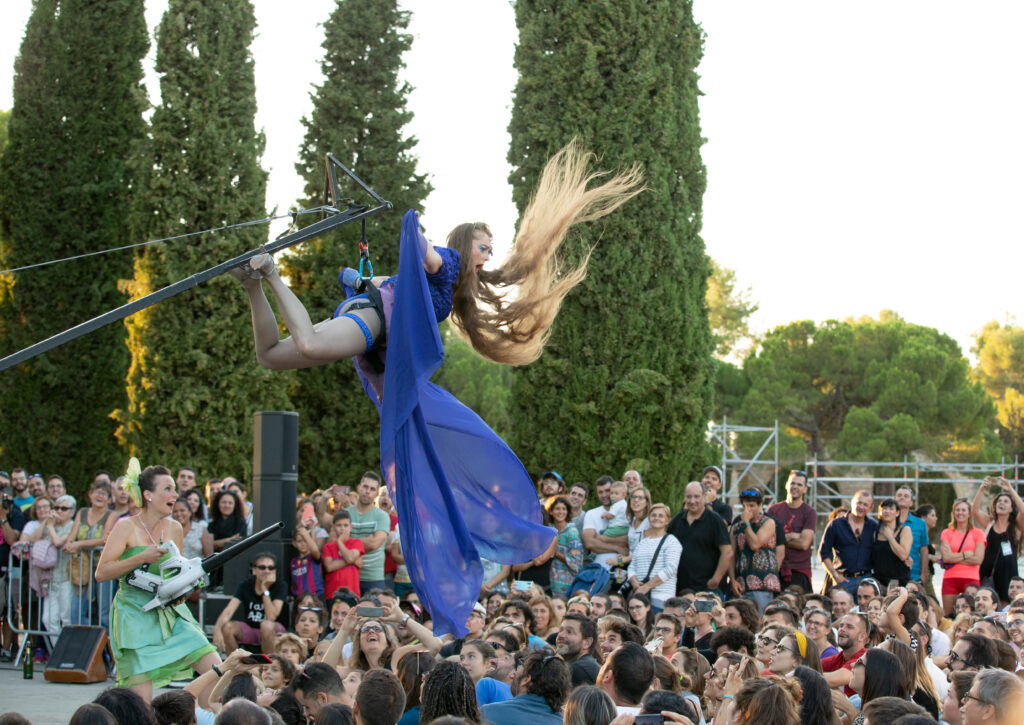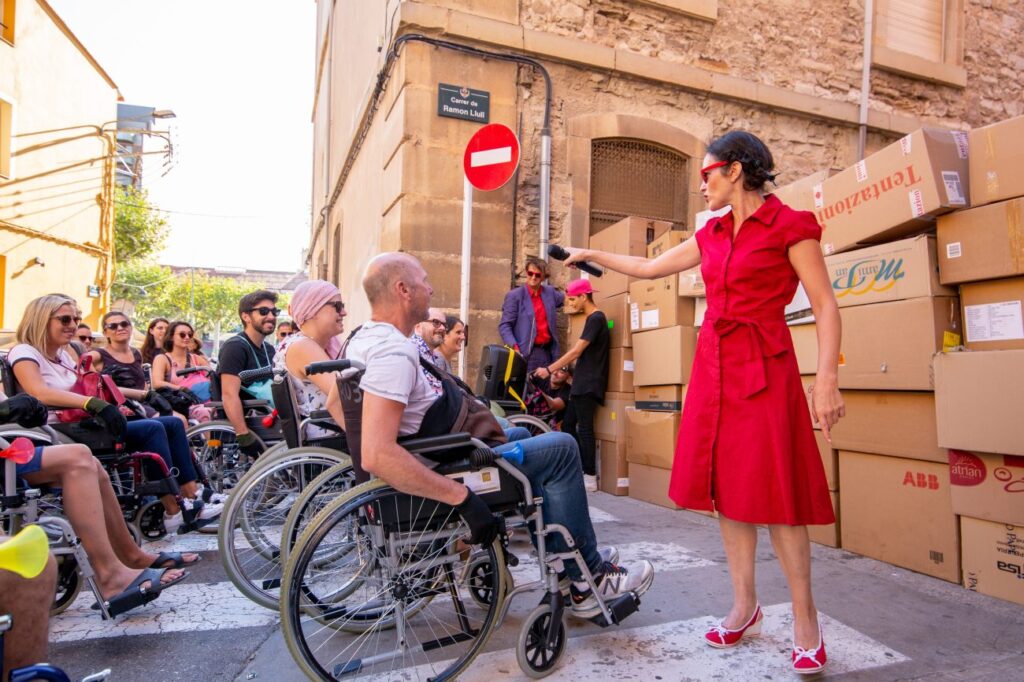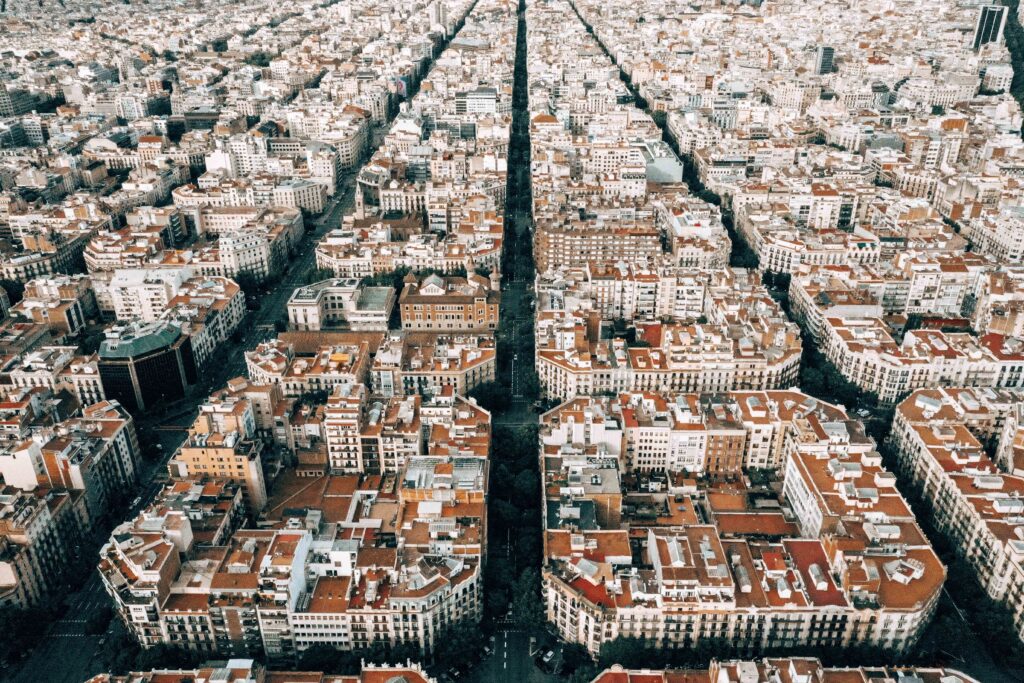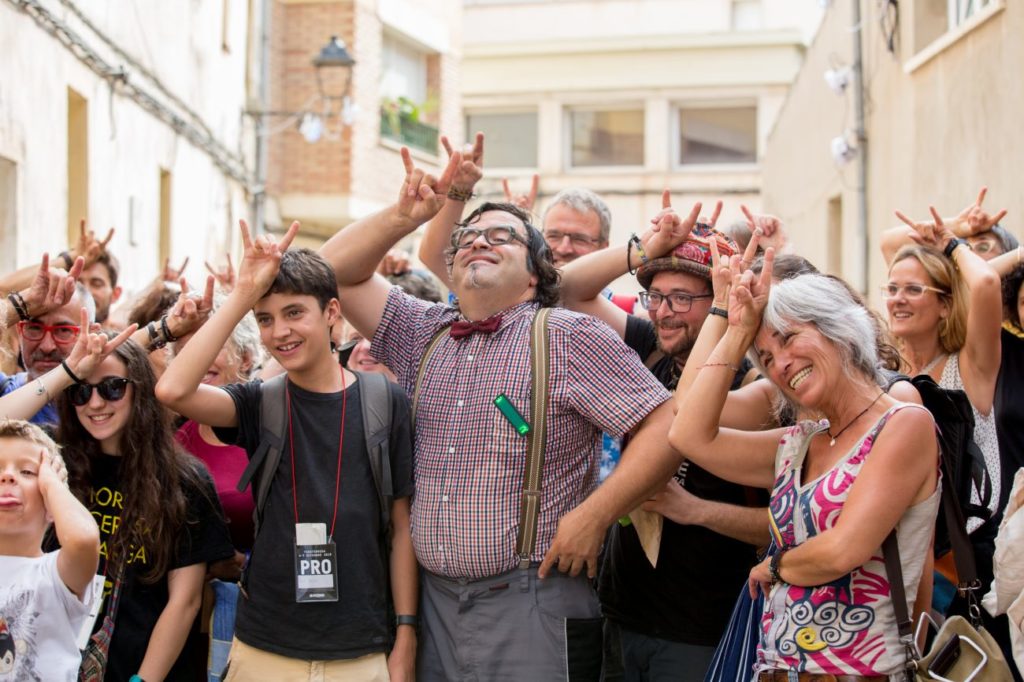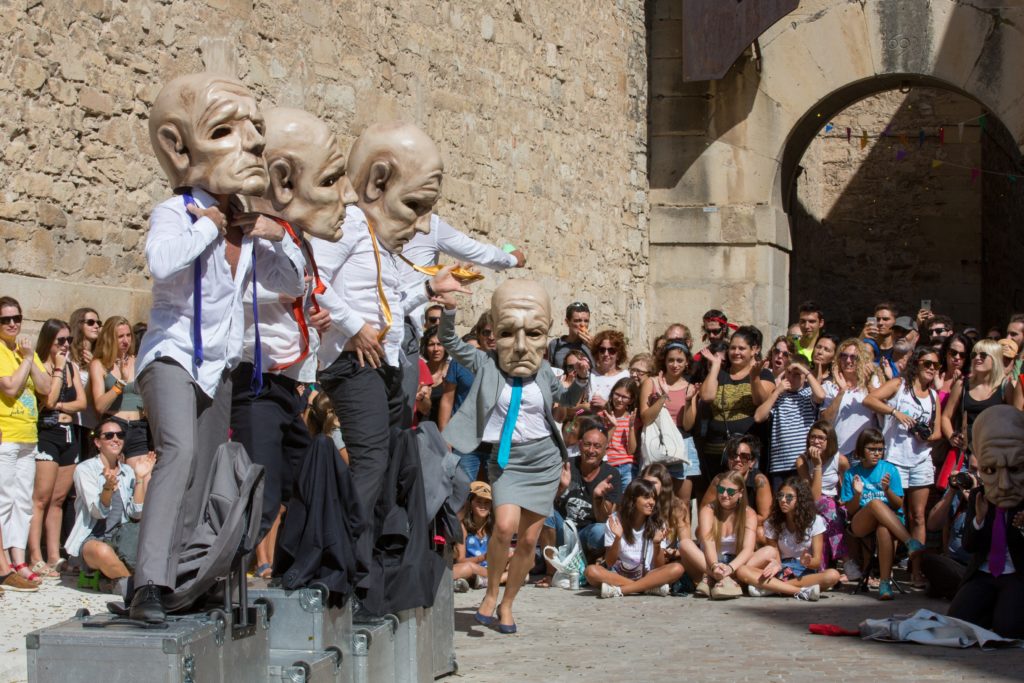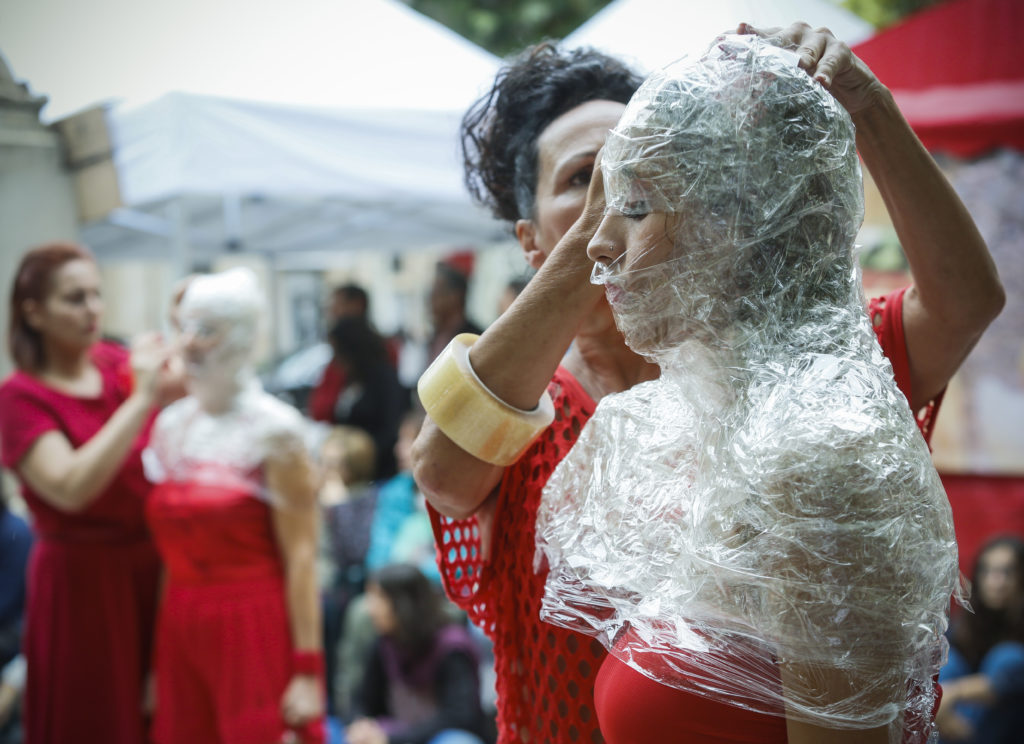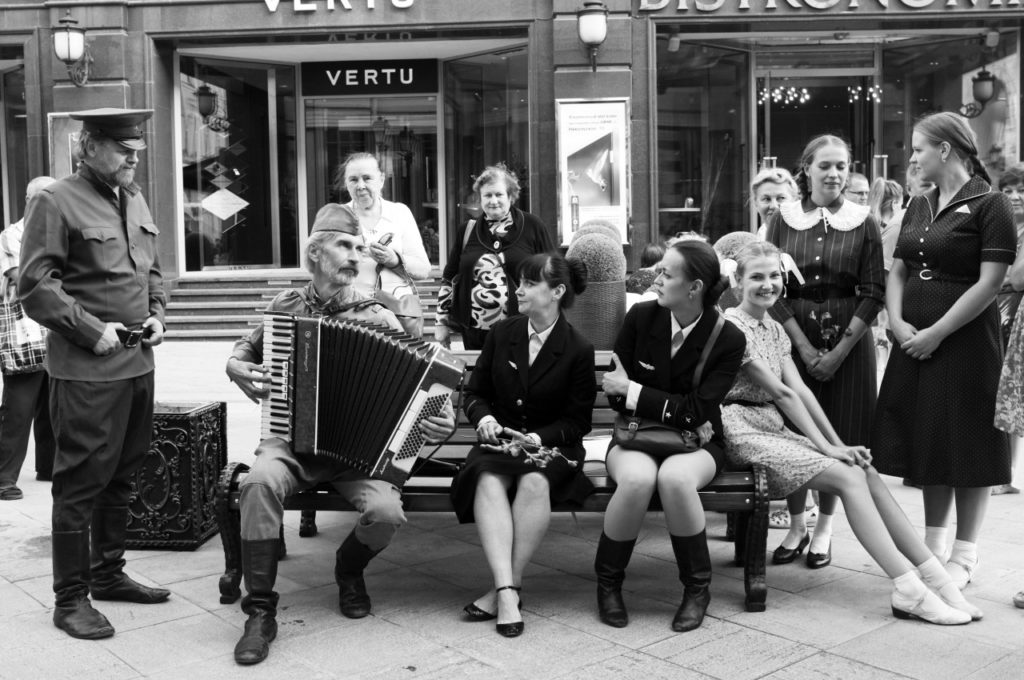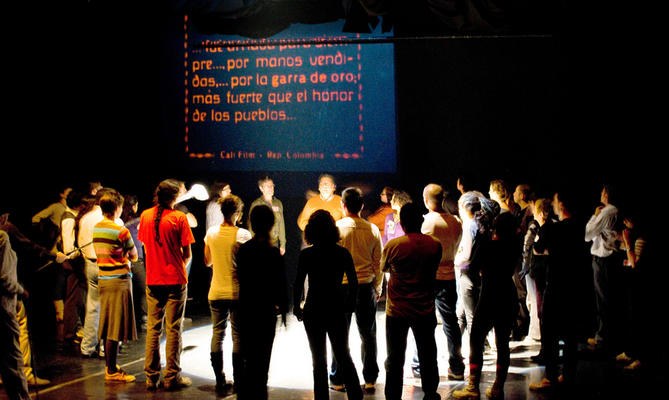-
Arts de carrer 28/09/2020 Àrea de comunicació
El arte callejero, los no lugares y la nada
Por Pau Llacuna i Ortínez
Creo que podemos decir que el arte callejero ha sido unos de los instrumentos más utilizados por las administraciones cuando su objeto era organizar un acto importante y llamativo; celebraciones de aniversarios, centenarios, milenios, grandes eventos o, simplemente, las fiestas patronales de cualquier pueblo modesto; se han servido del teatro callejero para lograr llamar la atención.
-
Art inclusiu, Arts de carrer, FiraTarrega, Innovació, Suport a la Creació 13/05/2020 Àrea de comunicació
El context
Per Lau Delgado Vilanova
Director Executiu de FiraTàrrega
L’emergència causada per l’epidèmia del Covid-19 ha suposat un gran impacte en tots els àmbits de la nostra societat. I, lamentablement, el cultural no n’ha estat una excepció. Els agents del sector estan buscant maneres de fer front a aquest impacte al temps que intenten concebre com han de canviar el seu model, la seva manera de ser i funcionar, per ser al més útils possible al sector i al ciutadà. Aquest fet està accelerant els processos de canvi o transformació en la missió, els objectius i les metodologies de funcionament de molts equipaments, esdeveniments i institucions culturals. Alguns d’aquests canvis hauran estat circumstancials, però d’altres, de ben segur, es consolidaran amb normalitat.
-
Arts de carrer, FiraTarrega, Urbanisme 06/04/2020 Àrea de comunicació
L’èxit internacional d’unes arts de carrer ingovernables
Catalunya és un dels màxims exportadors mundials de creacions en arts de carrer i espai públic. Però, quines en són les raons? Què explica aquest èxit i reconeixement internacional? Anna Giribet, directora de FiraTàrrega, ens ho explica en aquest article.
En la conversa inaugural de FiraTàrrega 2019, Xavier Antich deia que «l’espai públic és el lloc que els cossos acaben transformant; per això l’espai públic és literalment ingovernable». La vitalitat i riquesa de l’escena actual de les arts de carrer catalanes és un fet —reconegut internacionalment—, i per entendre-ho és imprescindible començar amb una aproximació des de l’urbanisme.
George-Eugèn Haussman, (polític, 1809-1891) va convertir París en una xarxa al servei d’una ciutat en moviment. Frederik Law Olmsted (arquitecte paisatgista, 1822-1903) va dissenyar un entorn rural com Central Park al cor de Nova York. Ildefons Cerdà (urbanista, 1815-1876) va idear un teixit urbanístic a Barcelona. Tres figures de l’època moderna que van canviar les seves ciutats. Més enllà de la forma, es van preocupar per la vida de la ciutat, la convivència. Haussman lluitava per aconseguir una ciutat accessible, Olmsted per una ciutat sociable i Cerdà somiava amb una ciutat igualitària. Accessible, sociable i igualitària. Llegir més…
-
FiraTarrega, General 02/05/2019 Àrea de comunicació
FiraTàrrega’s new direction
Anna Giribet Argilès, Art Director
Eduard Ribera, Head of Communication
Over the next five years FiraTàrrega will be embarking on a new creative and managerial project. As a result of recent changes to both the Fair’s directing positions these first few months have been spent in redoubling efforts to find the lowest common denominator that responds to the spirit of projects presented by Lau Delgado, the new executive director, and Anna Giribet, the new art director. Along with the rest of the team, we have been reflecting very seriously on what role we should play within the sectorial mechanism of the Generalitat de Catalunya’s strategic culture market. This process of reflection has prompted us to define a series of new action frameworks for the Fair to operate within over the next five years.
-
Arts de carrer 18/09/2018 Àrea de comunicació
Rellegir el carrer
Per Jordi Duran i Roldós, director artístic de FiraTàrrega
El carrer com a marc, presó o espai de resistència. I les arts escèniques com a motor de canvi social, evasió o propaganda. A FiraTàrrega rellegim l’espai públic. Una vegada i una altra, des de fa molts anys. Ens demanem per la vigència, la necessitat o el sentit de les arts de carrer. Ens preocupa la seva supervivència i el seu lloc al món contemporani. I no llencem la tovallola. Una fira, un festival, un teatre són espais protegits on se’ns permet somniar. Però quin lloc ocupa el somni en el nostre dia a dia? Quins permisos ens cal demanar? A FiraTàrrega també busquem sobreviure al context i a la institució pròpia, així com a les jerarquies del codi escènic i als barrots que representen la rutina o saber-se coneixedor d’alguna cosa. Ensumar, gratar, tastar el carrer per ser-ne conscients. Escoltar el seu batec, sentir-lo. Això és el que anhelem. Descobrir a fons el seu passat i entendre el seu present. Saber-ne més. No perquè hàgim de canviar res, sinó pel dret que tenim les persones a saber del món que trepitgem, pel dret que tenim les persones a somniar i a construir-nos un futur coneixedors de les nostres arrels, sabent per què actuem. No és només una manera de respectar i reconèixer la ciutat on vivim, és una manera de respectar i reconèixer aquell que l’habita. O la recorre amb nosaltres mentre caminem.
-
Art comunitari, Art inclusiu, Arts de carrer, Comunitat, FiraTarrega, Públics, Suport a la Creació 30/05/2018 Àrea de comunicació
Algo tiene la calle
Dimensiones de un hábitat creativo
por Oriol Martí i Sambola, Director ejecutivo de FiraTàrrega
La calle: tratar de describir la calle, de qué está hecha, para qué sirve
Georges PérecCrear en el espacio público es hablar con un lenguaje propio, desnudo, esencial y sincero. Y mucho más. Esto es lo que creo haber aprendido a lo largo de los años y lo que aquí propongo desarrollar desde lo teórico y lo conceptual.
Me refiero a las particularidades consustanciales de las artes escénicas (en mayor medida, por cercanía profesional) y de las artes plásticas, la música, la escultura o la instalación realizadas expresamente en la calle, la plaza, la travesía, el pasaje, el bulevar o la rotonda.
¿Cuáles son las particularidades de la calle cuando la entendemos como espacio creativo? Para afrontar esta cuestión es necesario un inicio antitético: se entiende cómo es la calle analizando cómo no es el recinto. Y hay análisis no antitético, no comparativo. Lo veremos también.
Este artículo identifica seis aproximaciones definitorias de la calle creativa: la dimensión urbanística, la política, la artística, la simbólica, la tecnológica y la atmosférica, presentadas a través de sus porqués, sus relatos y sus ejemplos. Llegir més…
-
FiraTarrega, Formació, General, Suport a la Creació 19/06/2017 Àrea de comunicació
Creation in town, Tàrrega calls for accomplice
By Mio Nakano, Cultural management master course student, intern at Fira Tàrrega Used to work on set decoration for films and TV commercials.
mionakano18@uic.esPlace + Story + Moment + You. You are the one who complete the affair.
For the shooting, we travel a lot. The shooting locations are the places you won’t go without a particular reason. They don’t attract tourist but if you wear special glasses of film maker, the sight will appeal to you with vivid color. Story is about ‘someone like you who lives an ordinary life’, so the location is in a little town away from any major city in a frequent situation. The location coordinator brings an empty modest house, and we the decorators revive the abandoned house. Bring a set of furniture, fill the fridge, plant flowers in the garden, and some supermarket receipts in the rubbish bin. The crew arrives. Director loves the set. Cameraman fix the angle. The lighting comes into the room more natural than sunlight. Shooting starts. Cut, OK. Another angle. The designer looks into the finder. Then says, ‘Mio, missing something.’ On the monitor, he points out this empty wall behind the face of the actor on rehearsal. We definitely should put something there, if not, this cut wouldn’t look lively. Something natural to hang on the wall, which creates atmosphere, maybe from the region, but not too flashy, goandfindityouhave10minutes. I start to run before he finishes the phrase. Llegir més…
-
Arts de carrer, Arts escèniques, Comunitat, FiraTarrega 12/06/2017 Àrea de comunicació
FiraTàrrega, a market but still a festival
Per Iryna Malinskaya, alumna del Màster en Gestió Cultural de la Universitat Internacional de Catalunya (UIC) iryshkamal@gmail.com
When getting an opportunity to be involved in organizational process of a performing arts festival, you find yourself thinking: what do I know about concepts and ideas laying deep under the surface? Are these implications obvious to the audience? Have I ever, being a spectator, realized a reason driving to partake in an organized crowded chaos?…
Launched mainly as a popular street festival, today the FiraTàrrega is the international market of performing arts, a place for promotion of new artists, creation, exhibition and training, a meeting point for professionals. But it remains a festivity for the public embodying originally rooted meanings of a festival as public joy and abstinence from daily life simply because of the so-called paradox of a spectator as Jacques Rancière stated – there is no theatre without a spectator.
-
Art comunitari, Art inclusiu, Arts escèniques, Política cultural 25/05/2017 Àrea de comunicació
Participación: crear en colectivo
Per Bernardo Tovar Samacá, alumne del Màster en Gestió Cultural de la Universitat Internacional de Catalunya (UIC)
Soy Bernardo Tovar Samacá, nací y me crié en Bogotá (Colombia), estudié Artes Plásticas y tengo formación en Ballet Clásico. Actualmente curso el Máster en Gestión Cultural en la Universitat Internacional de Catalunya (UIC) y realizo mis prácticas en FiraTàrrega. Junto con Mio Nakano e Iryna Malinskaya, provenientes de Japón y Bielorrusia respectivamente, trabajamos en diferentes aspectos relacionados con la programación del festival, bajo la dirección de Jordi Duran i Roldós.
Desde la constitución de este grupo, el concepto de participación ha direccionado la forma de trabajo. Esta heterogeneidad cultural aporta diferentes recursos y posibilidades, da riqueza y amplía los enfoques de las temáticas a desarrollar, aportando un carácter participativo e integrador. No por casualidad se conformó este grupo, sus características multiculturales evidencian una forma de aproximarse al concepto que guía la programación de FiraTàrrega para el presente año: la PARTICIPACIÓN. Concepto que busca desbordarse sobre la comunidad implicada en el festival, para hacerla sentir parte de un acto de creación común e incluyente.
El abordaje de un acto artístico a través de la participación y lo comunitario, permite hacer frente al aislamiento del arte y su exhibición en espacios privilegiados. También reestructura lazos de relación, fomentando un espacio de encuentro en el que se puede dialogar, reflexionar y proponer diferentes puntos de vista relacionados con distintas realidades, para pensar colectivamente sobre aspectos y problemáticas comunes. Llegir més…
-
Arts de carrer, Arts escèniques, Espectacles, Festivals, FiraTarrega, Suport a la Creació 06/03/2017 Àrea de comunicació
Poetry in action. Or some ways to go when something first starts
By Eva Marichalar-Freixa. Creator, arts based methods researcher@virginiafochs
Aquest text és una justificació i un document de partida del projecte internacional A Ferida / La Herida, coproduït entre el festival Imaginarius i FiraTàrrega que té una clara voluntat de diàleg artístic entre creadors catalans i portuguesos al voltant del concepte de la memòria. L’espectacle resultant s’exhibirà a l’edició 2017 de FiraTàrrega.
Here is some first data: City of Tàrrega, 2016/11/20 – 2016/11/23. During these days, Fira Tàrrega and Festival Imaginarius brought together a group of Catalan and Portuguese artists to set up the basis of a new project for research and co-creation between both countries; each artist was asked to create and perform a solo piece that would then be a part of a dialogue between them all. Some more data to continue: Our memories as a keystone to trigger conversations between two countries that have grown up turning their back on each other. Our memories as an opportunity for each artist to explore beyond his/her previous boundaries, simultaneously enhancing personal singularity. Our memories as a collective place where to dig into intimacy, so that we can then put them into conversation. This coproduction between both festivals will see its first premiere next spring at Festival Imaginarius, and then again in a new setting at FiraTàrrega in September. Confirmed artists are Rui Paixão, Catarina Campos, Alba Torres, Pau Masaló Llorà, Quim Giron Figuerola, and artistic director Julieta Aurora Santos.
On that first intensive meeting back in November, after being contacted by both festivals to outline and coach a methodology for this start-up encounter, I met the group with a very specific goal in mind: creating situations where active listening and favourable conditions for acknowledging one another could emerge. Each one should be introduced to the rest of the group by the means of the experience that was being shared by the whole group. Each one’s singularity should get the chance to be recognized at its right time during these first days, having also the opportunity to share previous personal creations and a professional profile that would then increase the possibilities of this collective project. Situations where outlined as in a three days dérive. I chased for those moments where to get lost and those where to be found, some moments to walk and some others to sit down around a table settled with some food and drinks, moments in solitude and moments to feel each other’s nearness, moments to talk to oneself and moments where to hold long and passionate conversations all together. Those where optimal moments to build up the foundational agreements of the whole process that was about to start: What was important for us to talk about? Which landscapes would take us and our stories in? What channels could facilitate growing up our conversations over the distance? How were we going to deal with production terms and conditions? It was important for me that each single decision to be made brought within the same melody, the same aesthetics that we could later on identify when enjoying the final performance first in Santa Maria da Feira and then in Tàrrega. During these days, I focused on those in-between spaces and times where nothing seems to happen, nevertheless, the most essential is being revealed. I cared for facilitating spaces and times where the group could build up a frame of mutual understanding where to go back to when feeling lost, a place where to feel at home quick after meeting again for intensive rehearsals before both premieres. After our kick-off encounter in Tàrrega, the team would be creating apart together; that is, they should start creating their solo pieces and the narrative that would join them all miles away from each other. Distance is a hard condition to play with; we knew that at some point, we would end up facing disenchantment. Therefore, building up a symbolic house which hosted the aesthetics of the relations braided on those first days was not only a key condition to overcome future concerns, but also the core of a previous need that would shift us from the pre-established idea of site-specific to that one of symbolic-specific, as I like to call it. It was during our stay in Tàrrega when we could feel the symbolic growing up strongly as a place, a house, a key idea, the heart of the creation. Translating that into words, the group decided to call it LA HERIDA / A FERIDA. Wounds came up as the formalization of all those agreements made during that first encounter, an appropriation of the concept that both festivals had asked us all to start up with, the official title and yet a symbolic space –that is, our home, our island, silence, a circle, a hole, flat and dimensional, a lived space, a space for deconstruction and construction, prohibition, omission, farce, disorder. Llegir més…

